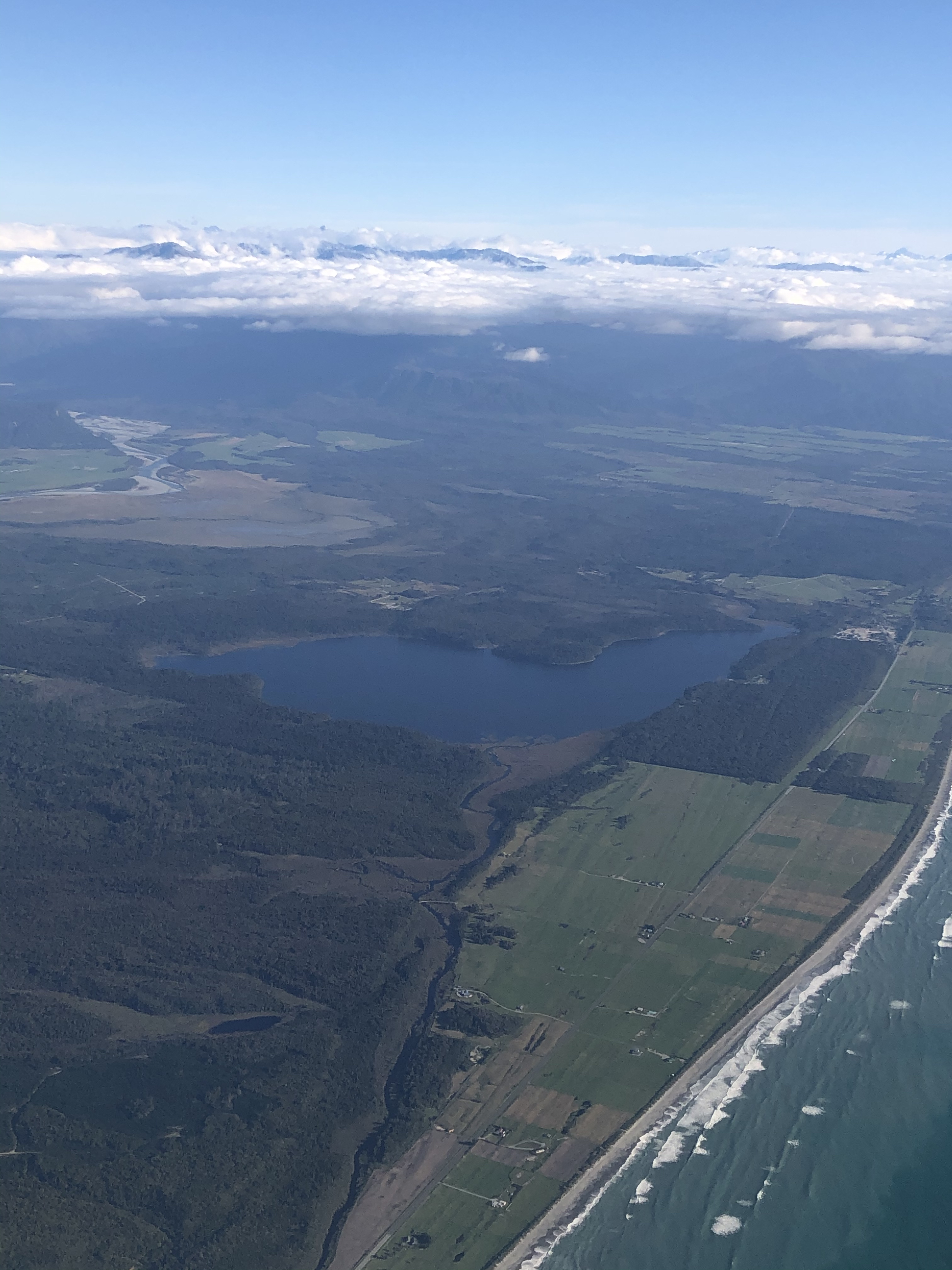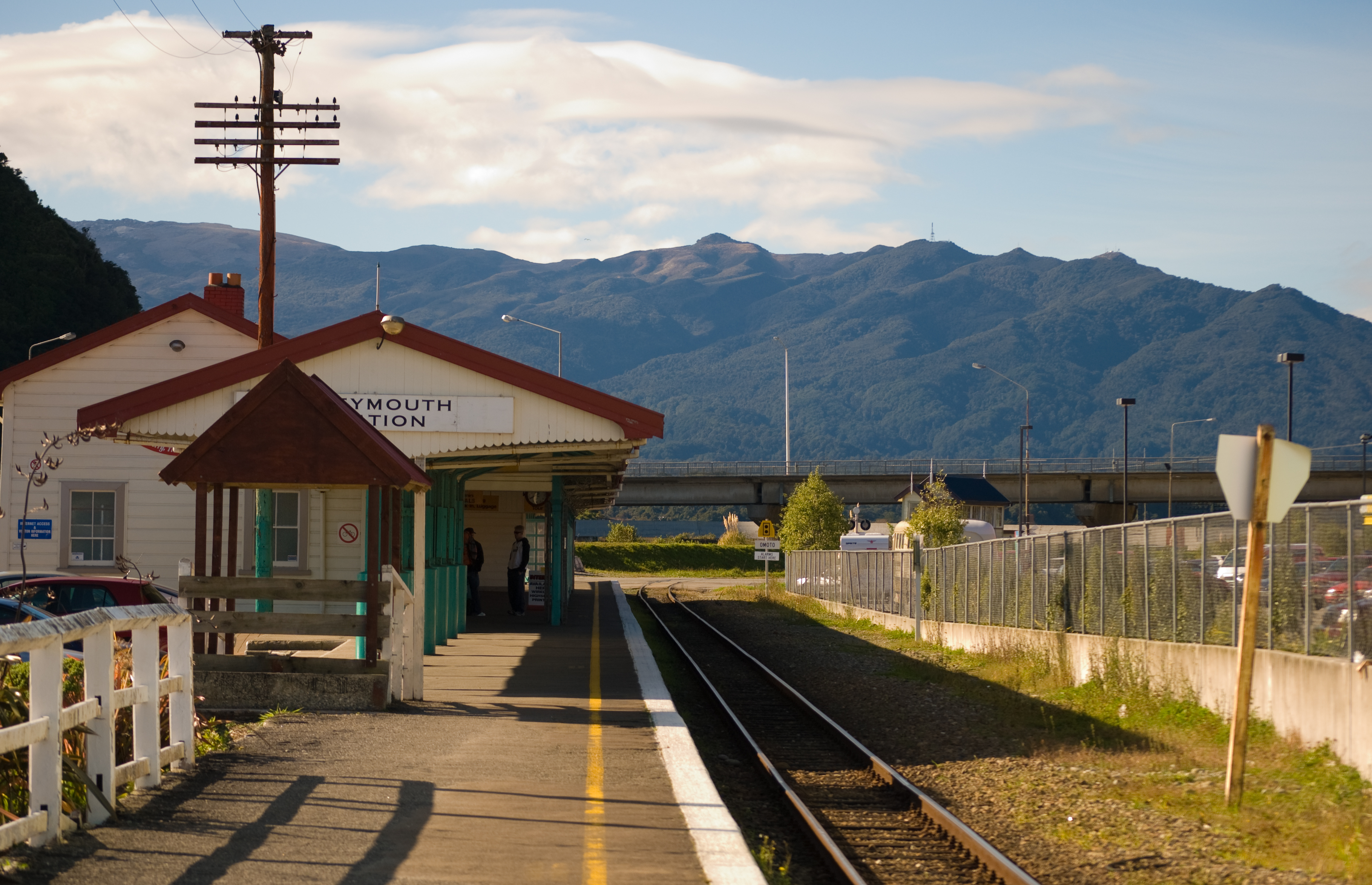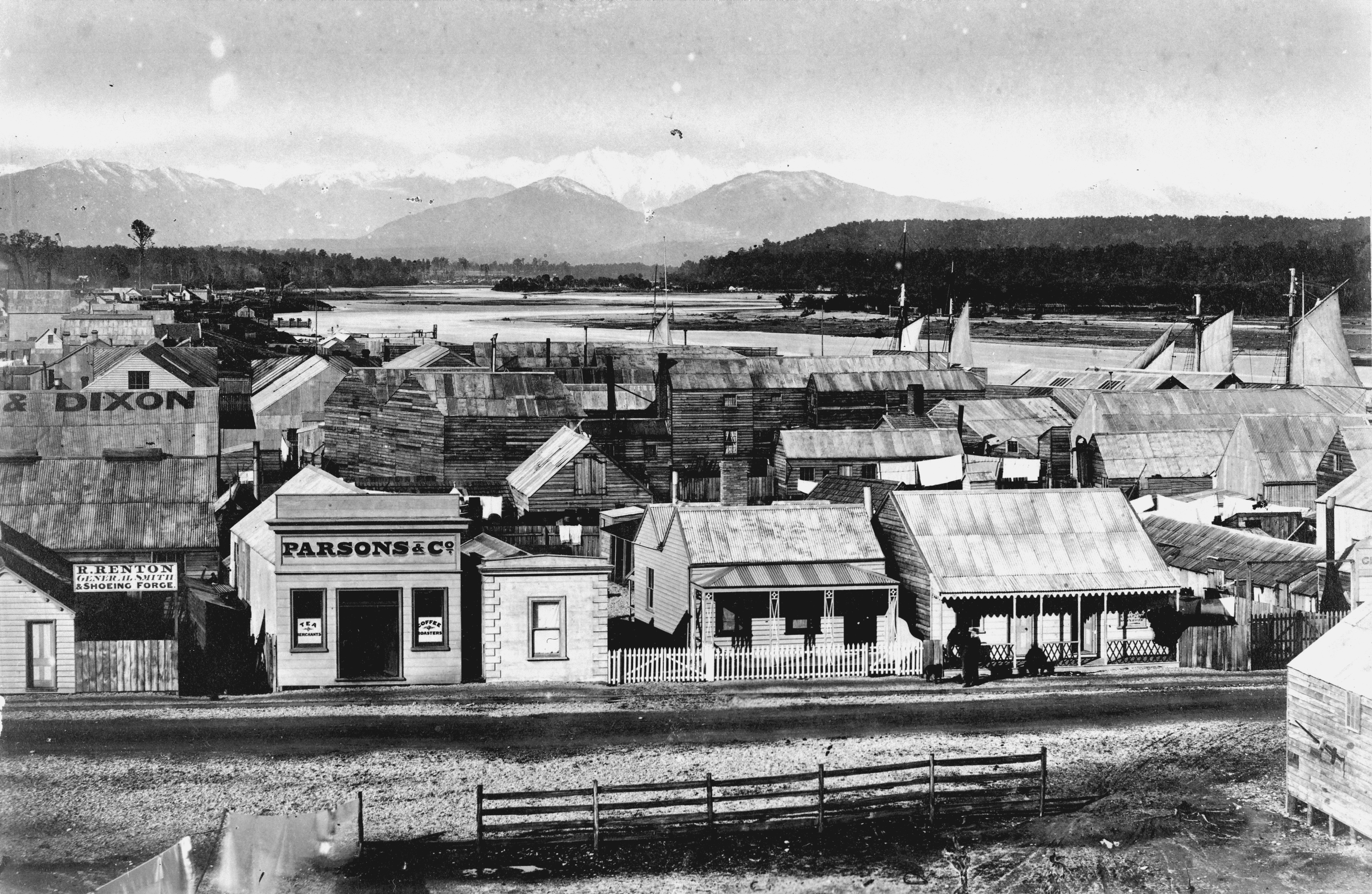|
Ruatapu, New Zealand
Ruatapu is a small town in the Westland District in the West Coast region of the South Island of New Zealand. The town's name stems from Ruatapu, a figure in Māori mythology. The town is located on a narrow strip of land between the Tasman Sea and Lake Mahinapua, a shallow lake that was originally a coastal lagoon. runs through Ruatapu, connecting it to the nearby towns of Hokitika and Ross. The town's economy is based upon agriculture, as well as a large sawmill, operated by Westco Lagan, which mills Radiata Pine for further processing in Christchurch. History Railway On 9 November 1906, the Midland railway line, running from Greymouth to Hokitika, extended a branch line to Ruatapu. Ruatapu acted as the terminus of the railway until 1 April 1909, when it was opened to Ross, and became known as the Ross Branch. Passenger services ceased on 9 October 1972 and the line closed to all traffic on 24 November 1980. Some of the track bed near Ruatapu can now be driven.David L ... [...More Info...] [...Related Items...] OR: [Wikipedia] [Google] [Baidu] |
Lake Mahinapua
Lake Mahinapua is a shallow lake on the West Coast of New Zealand's South Island. Once a lagoon at the mouth of the Hokitika River, it became a lake when the river shifted its course. Lake Māhinapua was the site of a significant battle between Ngāi Tahu and Ngāti Wairangi Māori, and is regarded by them as a sacred site where swimming and fishing are prohibited. In European times it was part of an inland waterway that carried timber and settlers between Hokitika and Ross until the building of the railway. Today it is protected as a scenic reserve for boating, camping, and hiking. Name The name comes from the Māori , a proper name, and , flower: Māhina's flower. There is not yet an agreed official spelling of the name in New Zealand English and it is commonly written without the macron, or with a macron on the second "a" (Mahināpua). Tūwharewhare / Mahināpua Creek's official name, confusingly, is currently spelled with a macron over the second "a". Geography The la ... [...More Info...] [...Related Items...] OR: [Wikipedia] [Google] [Baidu] |
Pinus Radiata
''Pinus radiata'' ( syn. ''Pinus insignis''), the Monterey pine, insignis pine or radiata pine, is a species of pine native to the Central Coast of California and Mexico (Guadalupe Island and Cedros island). It is an evergreen conifer in the family Pinaceae. ''P. radiata'' is a versatile, fast-growing, medium-density softwood, suitable for a wide range of uses. Its silviculture reflects a century of research, observation and practice. It is often considered a model for growers of other plantation species. It is the most widely planted pine in the world, valued for rapid growth and desirable lumber and pulp qualities. Although ''P. radiata'' is extensively cultivated as a plantation timber in many temperate parts of the world, it faces serious threats in its natural range, due to the introduction of pine pitch canker (''Fusarium circinatum''). Description ''P. radiata'' is a coniferous evergreen tree growing to tall in the wild, but up to in cultivation in optimum conditi ... [...More Info...] [...Related Items...] OR: [Wikipedia] [Google] [Baidu] |
Tramway (industrial)
Tramways are lightly laid rail transport, railways, sometimes with the wagons or carriages moved without locomotives. Because individual tramway infrastructure is not intended to carry the weight of typical standard-gauge railway equipment, the tramways over which they operate may be built from less substantial materials. Tramways can exist in many forms; sometimes just tracks temporarily placed on the ground to transport materials around a factory, mine or quarry. Many, if not most, use narrow-gauge railway technology. The trains can be manually pushed by hand, pulled by animals (especially horses and mules), cable hauled by a stationary engine, or use small, light locomotives. The term is not in use in North America but in common use in the United Kingdom, and elsewhere, where British Railway terminology and practices had large influences on management practices, terminology, and railway cultures such as Australia, New Zealand, and those parts of Asia that consulted with Bri ... [...More Info...] [...Related Items...] OR: [Wikipedia] [Google] [Baidu] |
Carter Holt Harvey
__NOTOC__ Carter Holt Harvey Limited is a privately-owned New Zealand-based company controlled by Rank Group Limited, the corporate vehicle of the country's richest man, Graeme Hart. Based in Auckland, New Zealand, the company has three main divisions: Woodproducts New Zealand and Woodproducts Australia, which are both major Australasian manufacturers of wood-based building products; and Carters, a New Zealand chain of trade-focused building supply stores. History (1872–2005) The company traces its history back ultimately to three namesake companies. The first of these was Robert Holt & Sons, a Napier-based company founded in 1921 (though Robert Holt's steam-powered sawmill began operations in 1872). The second was Carter Consolidated, whose sawmill ventures began under Francis Carter near Levin in 1896. Alex Harvey & Sons was the third – with humble beginnings manufacturing milk churns in Auckland. On 1 April 1969, Alex Harvey & Sons entered a three-way merger with L ... [...More Info...] [...Related Items...] OR: [Wikipedia] [Google] [Baidu] |
Fletcher Challenge
Fletcher Challenge was a multinational corporation from New Zealand. It was formed in 1981 by the merger of Fletcher Holdings, Challenge Corporation and Tasman Pulp and Paper. It had holdings in construction, forestry, building, and energy, initially just within New Zealand and then internationally as well, and at one time was the largest company in New Zealand. In 2001 it was split into three companies, Fletcher Challenge Forests, Fletcher Building (incorporating Fletcher Construction), and Rubicon. History The corporation was formed in January 1981 with the mutual merger of Challenge Corporation, Fletcher Holdings and Tasman Pulp and Paper. It was initially based in Wellington's Challenge House, but later moved in 1987 to a new head office in Penrose, Auckland. In 1987 the corporation acquired the state-owned enterprise Petrocorp, and created the Fletcher Energy division. Fletcher Energy's assets were subsequently sold to Shell New Zealand. In November 1993 Fletcher Challenge ... [...More Info...] [...Related Items...] OR: [Wikipedia] [Google] [Baidu] |
Kauri Timber Company
The Kauri Timber Company, Limited (KTC) Auckland was from 1888 to 1971 a large logging and sawmilling company in New Zealand. KTC was formed in 1888, with a capital of £1,250,000, paid up to £750,000, and its operations were of a very comprehensive nature. Besides KTC's headquarters in Melbourne and a branch in Sydney, there were sixteen branches in New Zealand, where the timber was milled, including Hokianga Sawmill Company. The forests owned by KTC made it the fifth-largest landholding company in the country, which removed much of North Island’s native forest, initially kauri and later kahikatea, assuring steady supplies for its mills for many years. Between 300 and 400 men were engaged in the Auckland mill and factory, and throughout the whole of the company's operations in mills, stores, and forests, some 5000 or 6000 people were employed. In its extensive export trade the company employed a large fleet of vessels, and was represented in the markets of Great Britain, Cap ... [...More Info...] [...Related Items...] OR: [Wikipedia] [Google] [Baidu] |
William James Butler
William James Butler (18 March 1858 – 10 December 1932) was a New Zealand sawmiller and timber merchant. He was born in Leamington, Warwickshire, England in 1858. He died in Wellington in 1932 and was survived by his wife. He was a brother of Joseph Butler Joseph Butler (18 May O.S. 1692 – 16 June O.S. 1752) was an English Anglican bishop, theologian, apologist, and philosopher, born in Wantage in the English county of Berkshire (now in Oxfordshire). He is known for critiques of Deism, Thomas .... References 1858 births 1932 deaths British emigrants to New Zealand New Zealand sawmillers People from Leamington Spa {{NewZealand-bio-stub ... [...More Info...] [...Related Items...] OR: [Wikipedia] [Google] [Baidu] |
Joseph Butler (merchant)
Joseph Butler (1 March 1862 – 30 September 1934) was a New Zealand sawmiller and timber merchant. He was born in Leamington, Warwickshire, England on 1 March 1862. He died in London in 1934, after having lived most of his life in New Zealand. He was a brother of William James Butler William James Butler (18 March 1858 – 10 December 1932) was a New Zealand sawmiller and timber merchant. He was born in Leamington, Warwickshire, England in 1858. He died in Wellington in 1932 and was survived by his wife. He was a brother o .... References 1862 births 1934 deaths British emigrants to New Zealand New Zealand sawmillers Businesspeople in timber People from Warwickshire {{NewZealand-bio-stub ... [...More Info...] [...Related Items...] OR: [Wikipedia] [Google] [Baidu] |
Track Bed
The track bed or trackbed is the groundwork onto which a railway track is laid. Trackbeds of disused railways are sometimes used for recreational paths or new light rail links. According to Network Rail, the trackbed is the layers of ballast and sub-ballast above a prepared subgrade/formation (see diagram). It is designed primarily to reduce the stress on the subgrade. Other definitions include the surface of the ballast on which the track is laid,, p. 386. the area left after a track has been dismantled and the ballast removed or the track formation beneath the ballast and above the natural ground. The trackbed can significantly influence the performance of the track, especially ride quality of passenger services. See also * Embankment (transportation) * Roadbed * Subgrade In transport engineering, subgrade is the native material underneath a constructed road,http://www.highwaysmaintenance.com/drainage.htm The Idiots' Guide to Highways Maintenance ''highwaysmaintenence. ... [...More Info...] [...Related Items...] OR: [Wikipedia] [Google] [Baidu] |
Ross Branch (railway Line)
The Ross Branch, officially known as the Hokitika Line since 2011, and previously as the Hokitika Industrial Line, is a branch line railway that forms part of New Zealand's national rail network. It is located in the Westland District of the South Island's West Coast region and opened to Hokitika in 1893. A further extension to Ross operated from 1909 until 1980. Construction The first line opened in the region was a bush tramway built to a gauge of 1,219mm (4 ft). It ran from Greymouth south to Paroa and opened in 1867. Ten years later, an extension inland to Kumara was opened, with the Taramakau River crossed by a cage suspended from a wire. Around this time, plans were formulated to replace the tramway with a railway and link Greymouth and Hokitika. Work began in 1879, but the economic conditions of the Long Depression brought construction to a halt the next year with only 5 km of track laid. Furthermore, the residents of Kumara, led by future Prime Minister ... [...More Info...] [...Related Items...] OR: [Wikipedia] [Google] [Baidu] |
Branch Line
A branch line is a phrase used in railway terminology to denote a secondary railway line which branches off a more important through route, usually a main line. A very short branch line may be called a spur line. Industrial spur An industrial spur is a type of secondary track used by railroads to allow customers at a location to load and unload railcars without interfering with other railroad operations. Industrial spurs can vary greatly in length and railcar capacity depending on the requirements of the customer the spur is serving. In heavily industrialized areas, it is not uncommon for one industrial spur to have multiple sidings to several different customers. Typically, spurs are serviced by local trains responsible for collecting small numbers of railcars and delivering them to a larger yard, where these railcars are sorted and dispatched in larger trains with other cars destined to similar locations. Because industrial spurs generally have less capacity and traffic t ... [...More Info...] [...Related Items...] OR: [Wikipedia] [Google] [Baidu] |
Hokitika
Hokitika is a town in the West Coast region of New Zealand's South Island, south of Greymouth, and close to the mouth of the Hokitika River. It is the seat and largest town in the Westland District. The town's estimated population is as of . On a clear day Aoraki / Mount Cook can clearly be seen from Hokitika's main street. Toponymy The name Hokitika translates from Māori as "to return directly" (from , 'to return', and , 'direct'). According to the Ministry for Culture and Heritage, the name comes from when a band of Ngāi Tahu warriors in search of greenstone were about to attack Ngāti Wairangi . The chief of the invaders drowned while trying to cross the Hokitika River, and the leaderless (army) then returned directly to their own home. History The land where Hokitika stands was purchased in 1860 from Māori when Poutini Ngāi Tahu chiefs signed the Arahura Deed. This was the sale of the whole of the West Coast region, apart from small areas reserved for Māori ... [...More Info...] [...Related Items...] OR: [Wikipedia] [Google] [Baidu] |



%2C_after_its_takeover_by_the_Kauri_Timber_Company_in_1888%2C_looking_east.jpg)



